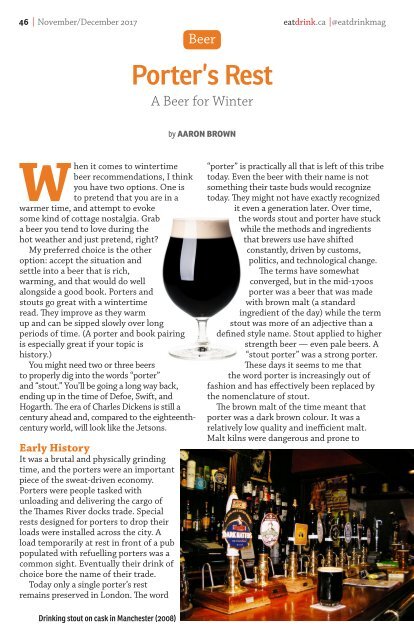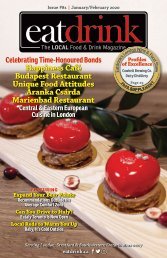Eatdrink #68 November/December 2017 "The Holiday Issue"
The Local Food & Drink Magazine serving London, Stratford & Southwestern Ontario since 2007
The Local Food & Drink Magazine serving London, Stratford & Southwestern Ontario since 2007
You also want an ePaper? Increase the reach of your titles
YUMPU automatically turns print PDFs into web optimized ePapers that Google loves.
46 | <strong>November</strong>/<strong>December</strong> <strong>2017</strong><br />
Beer<br />
Porter’s Rest<br />
A Beer for Winter<br />
eatdrink.ca |@eatdrinkmag<br />
by AARON BROWN<br />
When it comes to wintertime<br />
beer recommendations, I think<br />
you have two options. One is<br />
to pretend that you are in a<br />
warmer time, and attempt to evoke<br />
some kind of cottage nostalgia. Grab<br />
a beer you tend to love during the<br />
hot weather and just pretend, right?<br />
My preferred choice is the other<br />
option: accept the situation and<br />
settle into a beer that is rich,<br />
warming, and that would do well<br />
alongside a good book. Porters and<br />
stouts go great with a wintertime<br />
read. <strong>The</strong>y improve as they warm<br />
up and can be sipped slowly over long<br />
periods of time. (A porter and book pairing<br />
is especially great if your topic is<br />
history.)<br />
You might need two or three beers<br />
to properly dig into the words “porter”<br />
and “stout.” You’ll be going a long way back,<br />
ending up in the time of Defoe, Swift, and<br />
Hogarth. <strong>The</strong> era of Charles Dickens is still a<br />
century ahead and, compared to the eighteenthcentury<br />
world, will look like the Jetsons.<br />
Early History<br />
It was a brutal and physically grinding<br />
time, and the porters were an important<br />
piece of the sweat-driven economy.<br />
Porters were people tasked with<br />
unloading and delivering the cargo of<br />
the Thames River docks trade. Special<br />
rests designed for porters to drop their<br />
loads were installed across the city. A<br />
load temporarily at rest in front of a pub<br />
populated with refuelling porters was a<br />
common sight. Eventually their drink of<br />
choice bore the name of their trade.<br />
Today only a single porter’s rest<br />
remains preserved in London. <strong>The</strong> word<br />
“porter” is practically all that is left of this tribe<br />
today. Even the beer with their name is not<br />
something their taste buds would recognize<br />
today. <strong>The</strong>y might not have exactly recognized<br />
it even a generation later. Over time,<br />
the words stout and porter have stuck<br />
while the methods and ingredients<br />
that brewers use have shifted<br />
constantly, driven by customs,<br />
politics, and technological change.<br />
<strong>The</strong> terms have somewhat<br />
converged, but in the mid-1700s<br />
porter was a beer that was made<br />
with brown malt (a standard<br />
ingredient of the day) while the term<br />
stout was more of an adjective than a<br />
defined style name. Stout applied to higher<br />
strength beer — even pale beers. A<br />
“stout porter” was a strong porter.<br />
<strong>The</strong>se days it seems to me that<br />
the word porter is increasingly out of<br />
fashion and has effectively been replaced by<br />
the nomenclature of stout.<br />
<strong>The</strong> brown malt of the time meant that<br />
porter was a dark brown colour. It was a<br />
relatively low quality and inefficient malt.<br />
Malt kilns were dangerous and prone to<br />
Drinking stout on cask in Manchester (2008)


















